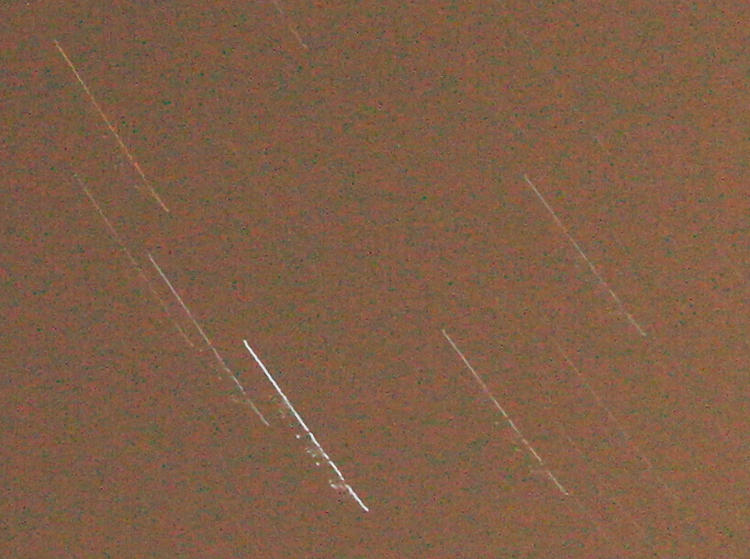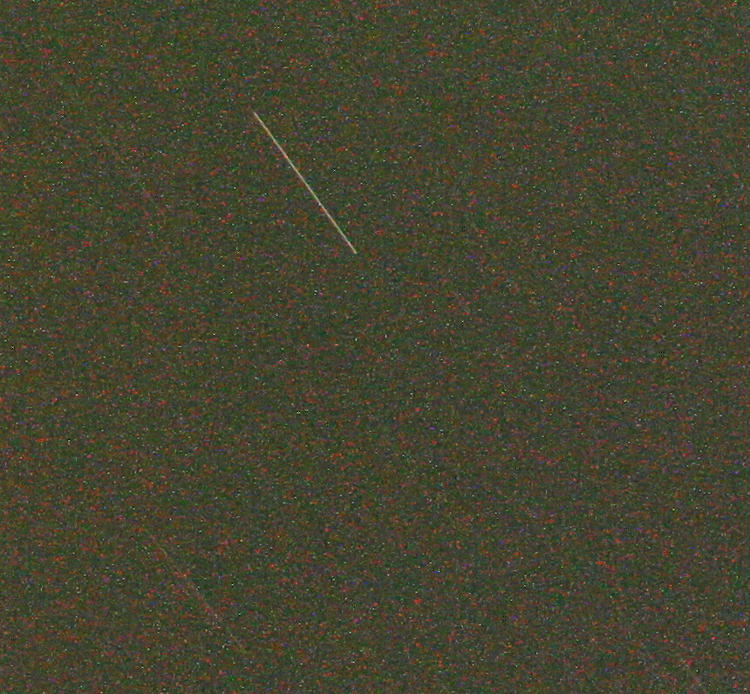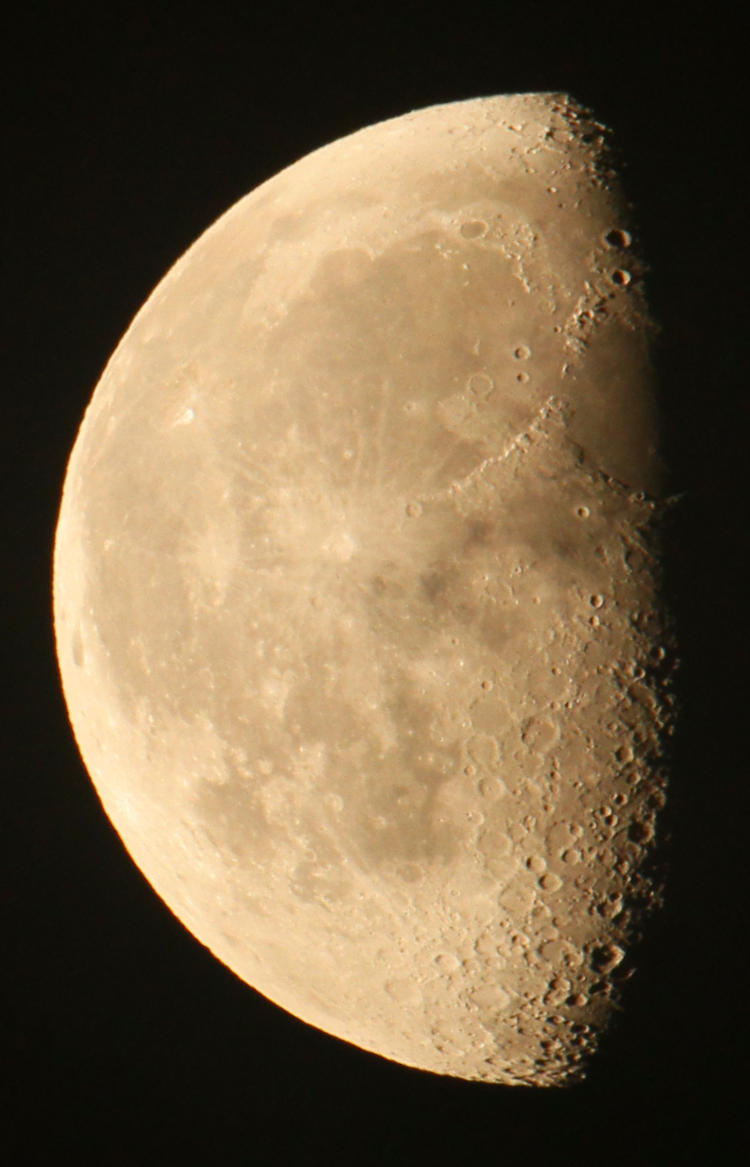I’d seen the skies looking quite clear yesterday evening, the first time in days, so I thought I’d try for the meteor storm, and early this morning (like a little after midnight,) I drove down to Jordan Lake, the best night sky spot in the area, to see what I could see.
The first thing was, the humidity was very high and the haze had rolled in, so only stars of higher magnitude were visible anyway, but what I was hoping to get weren’t the little, typical ‘shooting stars’ but a bolide, a nice fireball or at the very least, a brilliant, larger example – those would come through despite the haze.
On the first frame, I had the custom function of Long Exposure Noise Reduction set to ‘Auto,’ so it activated itself for the 800 second (13 minute, if you don’t know metric) exposure. Don’t do this; the noise reduction process can take as long as the damn exposure does, so I spent quite a while simply waiting for that to finish, unable to take any more exposures of the sky during that period, nor even turn the damn thing off in anticipation of the next frames.

It gets rid of sensor noise, but that’s a lot faster to do after the fact, and it didn’t significantly reduce the blotchiness of the night sky otherwise, which you’ll see in a second. And playing with the menu during the process might have been responsible for the bit below.

This is almost a full-resolution inset, and you can see that the color speckling is still present. This is ISO 400, by the way, so not particularly prone to this – any higher ISO setting would be progressively worse. But note the star trails themselves, and the little squiggle off to one side. I would put this down to tripod vibration in the stiff breeze, or even bumping the tripod, except that this doesn’t make sense. First off, in the length of exposure, vibration of any kind would be too minimal to register, taking place over the period of a second or two at most, and the stars would have barely moved across the frame in that time. Second, it displaces only to one side and returns right back to the original path, like the tripod was bouncing against the ground, prevented from going further to the right than it had been. For gaps to appear in the paths, ones that left squiggles behind, the tripod would have had to have moved that way very slowly, at least over ten seconds – and then returned to exactly where it was. In other words, horseshit. I can find no other reasoning than the process of noise reduction itself.
I shot several exposures, in some cases while watching the same area of sky, and in others watching all over the place. I caught a small flicker that might have been a meteor, out of the corner of my eye, but little else (I did see a bird going over quite low, though, an ominous dark and silent shape against the sky, but I couldn’t tell you what it was for sure – vulture, heron or eagle in size, anyway.) For one ten-minute frame, I attached the Tamron 10-24mm lens at 10mm for a wide field, aiming towards the plane of the ecliptic solely to show the diverging curves that occur, though the wide field can still distort the trails unrealistically anyway. But while that one was going, I saw a distinct meteor cut right across its field of view. Cool! I finally had one that I knew was a meteor, and knew it was within the frame.
Except, when I got back and unloaded, it really wasn’t visible.

The meteor was not dim, showing quite clearly against the stars, so it was at least their magnitude, and had a noticeable trail, not short – though it would have been reduced by the wider field of view. By my reckoning, it should have appeared in the upper left side of the frame (pretty damn close to the radiant of the alpha Capricornids as it were.) You can see some blotching up through just left of center, which does correspond to the position of the Milky Way at the time, even though I couldn’t make it out while there. The best I can say is that the meteor was aligned largely with the star trails and can’t be differentiated easily from them, though I’ve viewed the entire frame at full resolution and haven’t been able to find it. You may be looking at the one bright streak at upper left and thinking it’s too bright and too long, but here it is at full resolution:

I didn’t directly measure it against its dim neighbors, and I’m not sure I could get an accurate length off of them anyway, but it’s damn close. And the distinct uniform brightness along the entire length isn’t a good sign, nor being that precisely parallel to the others. No, that’s a star. Maybe, at some later point, I’ll find the evidence that I was sure I captured, but who cares? It certainly wasn’t what I was after no matter what.
The moon had risen right around the time I’d arrived at the lake, but remained behind trees from my vantage, and wasn’t bright enough to make more than trivial contributions to the brightness of the haze, but upon returning home, I had a good view of it and decided not to waste the entire morning.

That prominent crater down low on the terminator isn’t Tycho (which is off directly to the left of it, with the prominent ray pointing to it,) but Maurolycus, and yes, that’s sunset on the central peak – I could just barely discern this in the viewfinder, which told me that I was getting focus close. Still, I tweaked focus for every frame, knowing that critical sharpness is more a matter of chance that what can be determined through the viewfinder screen. White balance is set to Sunlight, so this is the color that was showing through the haze.
Maybe in a couple of days, I’ll aim for sunset on Tycho too, because why stop obsessing now?
* * *
Unrelated, but I’d mentioned waiting on a car window mount for a camera, which would have come in handy for this past trip to NY (well, both of them, though I hadn’t ordered it until after the first one.) After seventeen days in Greensboro, it finally left that facility (having been scanned as ‘leaving’ three times over two days) – only to arrive as a damaged, empty box. The staff and management at the Greensboro USPS Distribution Center is completely, utterly incompetent – this has been going on for years. Worse, the Inspector General knows about it, has audited multiple times, and it still goes on. Fucking hell, guys.



















































